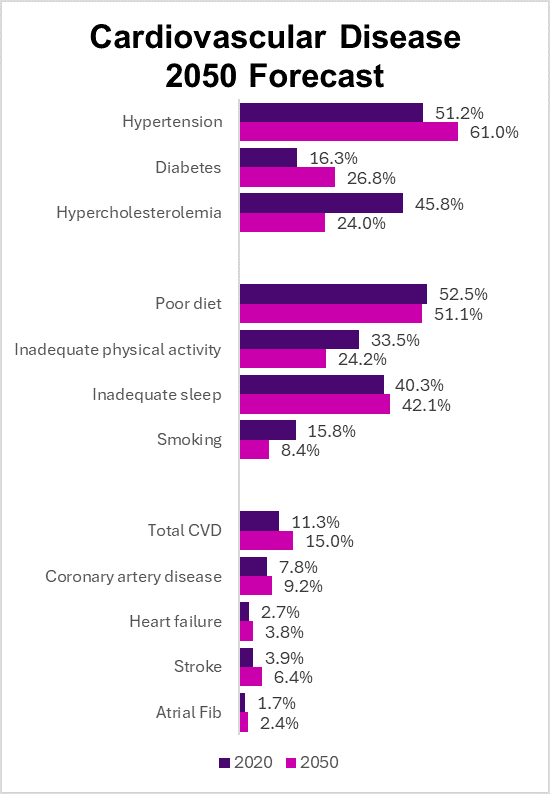Source: Maddox, et al Circulation June 4, 2024 LINK
The American Heart Association (AHA) has used the National Health and Nutrition Examination (NHANES) survey data set to estimate the likely burden of cardiovascular disease in the next quarter century. The headline is that increasing obesity and high blood pressure will lead to an increase in the rate of cardiovascular disease, and overall cardiovascular disease cost will triple over this period.
First the good news. The AHA projections suggest that the rate of adult behavior that increases risk of heart disease will generally improve over this time period. Fewer will smoke, fewer will have a poor diet, and more will exercise. Fewer will have high cholesterol due to more effective treatment. However, fewer will sleep well, and better sleep has been associated with lower risk of cardiovascular disease.
But there is more bad news. More than half of adults had hypertension as of 2020, and this study projects that rate to exceed 61% by 2050. Almost one in six adults (16.3%) has diabetes; that number will increase to more than one in four (26.8%). Some of the increase in cardiovascular disease is due to aging of our population, but much is due to increased risk factors including obesity, hypertension and diabetes.
A separate set of researchers used these projections to estimate the cost of cardiovascular disease. The researchers used inflation adjusted dollars, so this increase is due to increasing disease and utilization, not simply due to prices increasing each year.
Population level economic burden of cardiovascular disease including stroke 2020-50
Source: Maddox, et al Circulation June 4, 2024 LINK
The American Heart Association (AHA) has used the National Health and Nutrition Examination (NHANES) survey data set to estimate the likely burden of cardiovascular disease in the next quarter century. The headline is that increasing obesity and high blood pressure will lead to an increase in the rate of cardiovascular disease, and overall cardiovascular disease cost will triple over this period.
First the good news. The AHA projections suggest that the rate of adult behavior that increases risk of heart disease will generally improve over this time period. Fewer will smoke, fewer will have a poor diet, and more will exercise. Fewer will have high cholesterol due to more effective treatment. However, fewer will sleep well, and better sleep has been associated with lower risk of cardiovascular disease.
But there is more bad news. More than half of adults had hypertension as of 2020, and this study projects that rate to exceed 61% by 2050. Almost one in six adults (16.3%) has diabetes; that number will increase to more than one in four (26.8%). Some of the increase in cardiovascular disease is due to aging of our population, but much is due to increased risk factors including obesity, hypertension and diabetes.
A separate set of researchers used these projections to estimate the cost of cardiovascular disease. The researchers used inflation adjusted dollars, so this increase is due to increasing disease and utilization, not simply due to prices increasing each year.
Population level economic burden of cardiovascular disease including stroke 2020-50
Source: Kazi, et al Circulation June 4, 2024 LINK
Much of the increased medical costs are in those over age 65 and is borne by Medicare. However, the graphic below shows the impact of increased cardiovascular disease in those underage 65. In the commercial population, cardiovascular disease causes substantial economic productivity loss as well as increased medical costs.
Total cardiovascular costs by age
Source: Kazi, et al Circulation June 4, 2024 LINK
Behavioral risk factors for premature heart disease are generally declining, but not enough to blunt the increasing risk from obesity and an aging population. Higher rates of cardiovascular disease will lead to higher medical costs and more lost productivity.
Implications for employers:
Better treatment of obesity can help. But the current high price of GLP-1 medications means that their use will be limited. Employers can lower the cost sharing on other anti-obesity medications.
The increase in hypertension is especially concerning, and effective treatment of hypertension is inexpensive. Employers can ask their carriers to report regularly on hypertension control, which is a standard HEDIS reporting measure.
Employers can make first and second-line anti-hypertensives at the lowest cost share, to decrease any cost barriers to these effective medications. This can help address the problem that among the commercially insured with known cardiovascular disease, only 55% had adequate control in 2022.Employers can raise awareness of the risks of hypertension, and combine movement and exercise wellbeing programs with their anti-hypertensive efforts.
Stress management can improve hypertension and heart health risks. Employers can highlight stress management and resiliency programs available to their members through EAP or wellbeing programs.
Thanks for reading. You can find previous posts in the Employer Coverage archive
Please subscribe, “like” and suggest this newsletter to friends and colleagues. Thanks!
Tuesday: Provider directory inaccuracies persist




